The Friends of the Wildflower Garden, Inc.
Grasses of the Eloise Butler Wildflower Garden
The oldest public wildflower garden in the United States

Common Name
Wild Rhy (Canada Wild-rhy, Great Plains Wild-rhy)
Scientific Name
Elymus canadensis L.
Plant Family
Poaceae (Grasses)
Garden Location
Woodland & Upland
Prime Season
July to October
Grass structure and definitions - PDF from Oregon State University
Canada Wild-rye is a native perennial bunchgrass that can grow to 5 feet high. It has erect or arching stems (culms).
Leaves are waxy dull green, pointed, and are evenly distributed from the stem base to the flower spike. Blades are flat, wide (to 5/8 inch - 15+ mm), firm and usually ascending.
Sheaths, collars and ligules: Leaf sheaths are usually smooth, open, and often reddish-brown. Auricles are present and from 1.5 to 4 mm long, brown or purplish black. Ligules are short, 1 mm, truncate with ciliolate edge.
The inflorescence: Seed production is on a terminal spike, up to 12 inches long and 1 to 2.75 inches wide. It is usually nodding once the fruit develops. Spikelets develop at the nodes of the spike, 2 or 3 per node, sometimes up to 5, but rarely 1.
The spikelets are thick and bristly, 0.5 to 1.6 inches long (12 to 20 mm) exclusive of the awns. Each spikelet has 3 to 5 florets, with only the lowest being functionally fertile. The two glumes are about equal in size, 6 to 13 mm long (11 to 40 mm long including their awns). They are 3 to 5 veined, smooth, except there can be some rough edge hair. The awns are long, straight to curved outward. (An awn is a bristle-like appendage that responds to changes in atmospheric moisture by coiling and uncoiling and this helps ratchet the seed into the soil.) The lemmas are 8 to 15 mm long and also have awns, 15 to 40 mm long, which are always outcurving. Florets have 3 anthers. Ripe fruit separates from the spike just above the glumes and beneath each floret.
Habitat: Wild Rhy forms loose tufts and rarely has rhizomes. This is a cool season grass that is short-lived but after seed maturity can regenerate growth and be useful for fall forage. Seedlings establish readily but are not competitive with other grasses, so you will often find it in areas without a lot of other competition. It is tolerant of drought and is very cold hardy. It can be used for livestock forage in the early and late part of the growing season and wildlife also find it palatable. It is susceptible to leaf and stem rust. This species is the best known of the many Wild Rye grasses and is a dominant grass of the prairies.
Names: The genus Elymus is taken from the Greek elyo, meaning 'rolled-up', being a name for a type of grain where the lemma and palea are tightly rolled around the seed. The species, canadensis, means 'of Canada' where it was originally typed. The author name for the plant classification - 'L.' refers to Carl Linnaeus (1707-1778), Swedish botanist and the developer of the binomial nomenclature of modern taxonomy.
Comparisons: E. riparius, the Eastern Riverbank Wild-rhy is similar but with straight awns. That species is not found in Minnesota. E. wiegandii, Wiegland's or Northern Riverbank Wild-rhy, does have outcurving awns, but there, the spikelets are always 2 per node, and leaf blade veins usually have spreading hairs and the entire upper blade surface has thin fine hair. This species is found in Minnesota, but only in a few northern counties as it requires a more moist, cooler habitat. E. villosus, Downy Wild-rhy, also found in Minnesota, also looks similar, but the awns are straight and the upper leaf surfaces and the sheaths have dense fine whitish hairs.

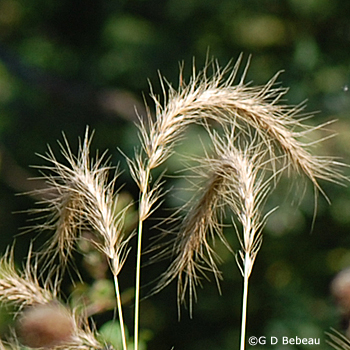
Above: Flowering heads of Canada Wild-rye in the green stage in July -1st photo- and at maturity in late September - 2nd photo. Awns become more outcurved at maturity.
Below 1st photo - Floret detail, 2nd photo - glume detail. Both photos ©Anna Gardner, University of Iowa.


Below: Drawing courtesy USDA-NRCS PLANTS Database / Hitchcock, A.S. (rev. A. Chase). 1950. Manual of the grasses of the United States. 2nd photo - detail of developing spiklets, note the veins on the glumes.

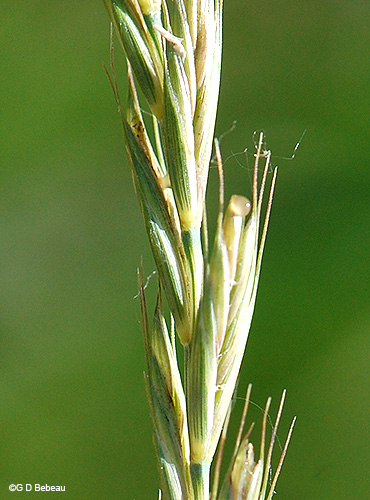
Below: Detail of the sheath and ligule and the enveloping auricle which can typically be brown or purplish-black.

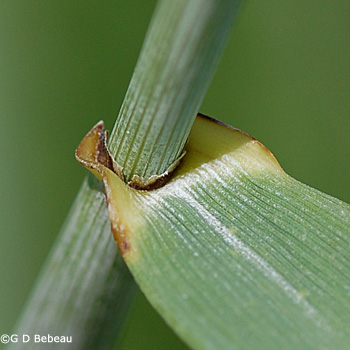
Below: 1st photo - leaf blade detail. 2nd photo - note on the developing July seed head that the awns are not as outcurved as they are when the seeds mature.
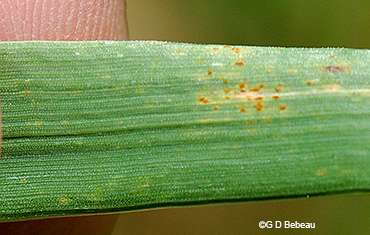

Below: Spikelets of Canada Wild-rye; Green state and at maturity.
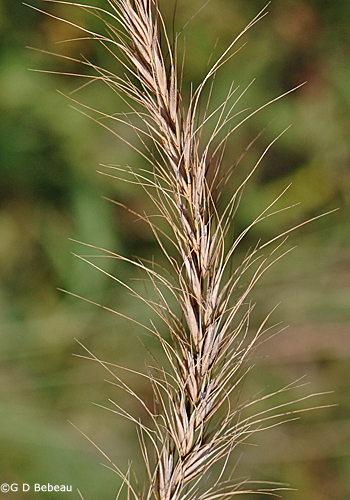

Notes: Canada Wild-rhy is indigenous to the Garden. Eloise Butler catalogued it on Sept. 6, 1907. Gardner Cary George noted planting it in 1995.
Wild Ryes are native grasses to most of the United States and Canada. The most common species is Canada Wild-rye, Elymus canadensis L. In Minnesota that species is found throughout the state in all but a dozen counties.
Canada Wild-rhy is one of nine species of Elymus found in Minnesota. The others are mostly all other native species of rhy grass. The lone exception is the non-native Quackgrass. Other species of Elymus found in the Garden are Quackgrass, Elymus repens and Eastern Bottlebrush Grass, Elymus hystrix.
Return to -- Site Plan/Archive Index --or-- List of Common Plant Names -- or -- List of Scientific Names -- or --Home Page - - - Back to top.
References: Plant characteristics are generally from sources 1A, 32, W2, W3, W7 & W8 plus others as specifically applied. Distribution principally from W1, W2 and 28C. Planting history generally from 1, 4 & 4a. Other sources by specific reference. See Reference List for details.
 Identification booklet for most of the flowering forbs and small flowering shrubs of the Eloise Butler Wildflower Garden. Details Here.
Identification booklet for most of the flowering forbs and small flowering shrubs of the Eloise Butler Wildflower Garden. Details Here.
©2013
Friends of the Wildflower Garden, Inc. Text and photos are by G. D. Bebeau unless otherwise credited. "www.friendsofeloisebutler.org"
040620